Test Report Scanner Microtek ScanMaker s480
At the end of the year 2007, Microtek introduced with the ScanMaker s480 a low-priced flat bed scanner into the market. With the integrated and relatively big transparency unit for the digitalization of the film material and the light guide that is integrated in the cover for the comtemplation of the transparent originals, the device is designed for photo appliances.
The low priced flat bed scanners with integrated transparency unit are normally suitable for reflective originals, but most of the times they also do not provide very satisfying results in the case of transparent originals. Our test report will show if the ScanMaker s480 is here an exception.
Equipment, Accessories and Performance Data of the Scanner
The small and flat Microtek ScanMaker s480 disposes of a scan surface of a little more than the size of DIN A4 (21,59 cm x 29,72 cm) for reflective originals and a transparency unit sized 12,7 cm x 25,4 cm. At the upper side of the cover, there is a light guide integrated that is provided with light by the light source of the transparency unit. Thanks to its size of 12,7 cm x 15,24 cm, also big format films of 4x5 inch can be easily examinated.

The cover that is connected to the scanner over a connection cable can be moved in parallel for approximately 2 cm from the scan surface upwards or be completely removed, so that also thick originals as books can be put on. Therefore, the narrow and sloped border of the scan surface is very useful. By this way, the books can be positioned on the glass plate with the fold at the scanner border without causing any damage and they can be scanned without any distortions and fold shadows.
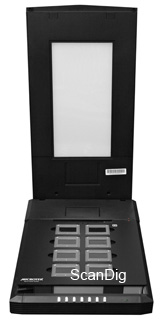
At the front part of the device, there are, beside of a green status-LED, seven scanner buttons. Six of them have some determined functions, one (the custom-button) can be freely assigned. The six functions are: interruption of the scanning procedure and/or call up of the Microtek scanner configuration, scanning, copying, sending e-mail, text recognition (OCR), and creation of a PDF-document. With the help of the Microtek scanner configuration, the functions of the buttons can be configurated: by this way, options as selected directories and computer applications as also the function of the custom-button can be configurated.
Everything what is needed to digitalize reflective and transparent originals is included in the scope of delivery of the des Microtek ScanMaker s480. Beside the obligatory connecting cables for electricity and the USB 2.0-connection, a software-package, a white covering for the scannings of reflective originals as also four film adapters are also included in the carton.
There is a film adapter for eight framed small image slides, a film adapter for three filmstrips of small image with each up to a length of six images, a film adapter for a medium format filmstrip of manimum 22 cm and another flim adapter for two flat films of 4x5. The fasteners consist on a flexible plastic and seem to be quite resistant.
Microtek indicates for the ScanMaker s480 a maximum optical resolution of 4800 x 9600 ppi and a colour depth of 48 bit. There is no indication of the range o density and/or the maximum density, and we will show how far the scanner can really approach this mentioned resolution in the following chapter Image Quality.
Installation and Initial Operation
Before the scanner is connected with the electric circuit and the computer, the software has to be installed. According to the quick-start instruction, there is only the CD to be put into the drive and to follow the instructions on the screen. But it did not work so easily with the CD that was attached to our test device. The AutoStart-file that is normally included in a software-CD and that after inserting it, it autonomously starts the installation program, was not available. On the data carrier, there only were the files of the different appliances that have to be installed individually through the manually starting of the respective setup-file. If this is also the case of the delivered devices and/or CDs to clients, for people who are versed in computers, this is not a problem. To the contrary, someone who has only little experience or no experience at all with the PC, will probably not be able to continue.
Once the software is installed, the scanner must only be unlocked, connected to the electricity through the power supply and be connected to the PC via USB 2.0. By switching on the device with the tappet switch at the backside, it will be automatically regognized by the operating system. Now the scanning can start.
The provided Software
The software package that is delivered with the ScanMaker s480 consists on the scansoftware ScanWizard 5, the OCR-text recognition program ABBYY FineReader Sprint, the Adobe® Acrobat Reader as also the media administration program InterVideo MediaOne Gallery.
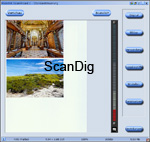
The ScanWizard offers two operation modi: the standard control and the professional control. In the standard control, the software offers some very reduced possibilities of adjustment. Beside the adjustment of the selected directory and/or the selected appliance, the type of the original and the image mode (colour, grey scales, black / white) can be chosen form a list of appliances of the scan. Therewith, the resolution is determined, whereby the option "free", also an arbitrary resolution can be choosen.
The output quantity can be determined in five stages between 50% and 200%. Furthermore, there is a control for the brightness, contrast, sharpness, colour and saturation, and by a sliding controller, the preview-image can be zoomed in and out.
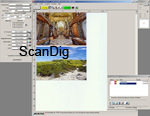
By changing to the professional control, the appearance of the program reminds on SilverFast: people know from the professional software of LaserSoft Imaging a separate window for each of the different program elements as image settings, image pre-view and densitometer. Only in this mode, the images can be freely scaled and all possibilities of adjustment can be used. Thereby, all usual tools as the tonal value correction, gradation curves, brightness/contrast and colour correction are available. Moreover, the software offers a choice of filters to re-sharpen the image and a function for removing the Moiré-effect. The batch processing of several images is also possible.
Thus, the scan software of Microtek has certainly nothing to be ashamed of and offers a stunning abundance of adjustments for a device of such a price level.
Scanning Reflective Originals
As a flat bed scanner, the Microtek ScanMaker s480 is specialised on the digitalization of reflective originals as for example paper fotos; the scanning of slides and negatives is rather to consider as an extra.
The scaning of paper fotos works in a simple and usual way. The Scanwizard can either be operated as a stand-alone-appliance or be started from an appliance as for example an image processing program. The scanner is equipped with the originals to be scanned, a preview-scan is made, the desired adjustments are made and finally, the fine scan is started. It is accomplished in an acceptable speed and the finished image is then either saved in a previously determined place or sent to a determined appliance.
As we are mainly interested in the aptitude of the s480 for slides and negatives, we will not get deeper into the scanning of photographies and documents.
Scanning of Framed Small Image Slides
For scaning the framed small image slides, first the rspective film adapter is to be placed on the scanning surface. As a positioning help for all film adapters there is only a red arrow at the scanner and at the film adapter that had to be aligned to each other. The holders can not be fixed.
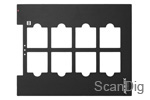
The slide adapter captures up to eight slides that have to be inserted with the side of view down. It is about a pattern that determines the position of each of the slides by the respective cutouts. Thus, the slides are put after the pattern, with the side of viwe down, stright on the glass plate. For the easy removal, the cutouts have a semi-circular convexities at the left and at the right side for the fingers.
Due to its structure, the slide adapter can capture frames of all thicknesses. But it also has some big disadvantages. During the removal, one inevitably pollutes the scan surface as long as one does not wear any cotton gloves, and the slide adapter can be only loaded within the scanner, a thing that can eventually make the work uncomfortable. Other scanners do provide some better solutions: If one can load the film adapter outside the scanner, the work is much more easier.
Once the scanner and/or the film adapter is loaded with the oiginals, a pre-scan is made and thereafter, an automatic image distribution is accomplished. But this certainly does not work very well, so that the scanning frames have to be corrected manually. If several scanning frames are drew on, during the fine scan, these are automatically processed, one by one, in the batch modus.
Scanning Small Image Filmstrips
The small image film adapter that is included in the scope of delivery of the Microtek ScanMaker s480 can capture three filmstrips wth up to six images each. These are pushed into the adapter, so that the risk of scratches is very high. Also here, the use of some cotton gloves is recommendable in order not to leave additionally some fingerprints on the filmstrip during pushing it in.
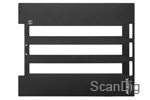
Moreover, we recommmend the use of some special tweezers in order to remove carefully the filmstrips from the archive folders/photobags. As the filmstrips are pushed in, the adapter can be also loaded with several short film pieces as also with strongly arched or rolled strips.
The automatic image distribution works better in the case of filmstrips as in the case of slides, so that most of the times, the scanning frames do not have to be corrected. Also the special formats as the half format or a panorama format can be scanned by the respectve adaptation of the scanning frames.
Scanning of Medium Format Films
The ScanMaker s480 of Microtek can not only digitalize small image formats but also some larger film originals. The medium format film adapter of the ScanMaker s480 holds up a filmstrip of nearly 22 cm length. Respectively, four images of the format 4,5x6, three images of the format 6x6, two of the format 6x7 (in case of very narrow image borders, three images), 6x8 and 6x9 or one of the format 6x12 can be inserted at once.
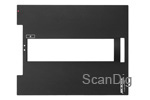
Also here, the filmstrip is pushed inside the film adaptor. By this way, it is hard to avoid some scratches. As it is the case of the small image filmstrip adapter, it is also applied in the case of medium format films and several short film pieces as also strongly curved and/or rolled filmstrips are tightened and can be therewith scanned without any problem, kudos for this to the ScanMaker s480.
The automatic image distribution works well, but in the case of medium formats it is not as necessary as it is in the case of small formats. Also the special formats as for example the 6x17 cm panorama-format can be digitalized by the manual adaption of the scanning frame.
Scanning of Large Formats
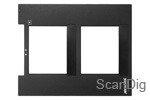
With the Mikrotek ScanMaker s480 also large format films can be scanned. Films sized 4x5 inch can be inserted at the same time in the respective film adapter. Unfortunately, the smaller format of 9x12cm does not fit in.
Also the large format films have to be inserted into the adapter, so that here, the problem of the scratches is also present. Without some cotton gloves there is no chance to get the film into the adapter without any fingerprints. An automatic image recognition is also possible that in case of this film format also works quite reliable.
The scanning of large formats makes the s480 to be an allrounder, but it is a pity that only 4x5" formats can be scanned. Unfortunately, there is no film adapter for other large formats, neither optionally.
Image Quality
Now we will look how the image quality of the Microtek ScanMaker s480 is. As it is a low-priced flat bed scanner with a transparency unit, the expectations concerning the transparency scans should not be too high.
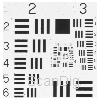
During a resolution test with an USAF-testchart, the horizontal lines of the element 4.4 and the vertical lines of the element 4.6 are bearly distinguishable. Thereform, a medium effective resolution of only 1300ppi results. This is only 27% of the resolution declared by the producer that is of 4800ppi. This is sufficient for scans of reflective originals and often also for large format films. But for the digitalization of smaller film formats, the resolution is not sufficient for many applications.
Thus, during a scan in the highest resolution (1300 dpi effective), a small image (film of 35mm) barely provides 2,3 megapixels of image information; this is less than what the low-priced digital cameras for beginners provide. A small image negative or a small image slide that is scanned with 1300ppi, can be enlarged without any loss of details with a print resolution of 300 ppi, that is usual during the print processes on photo paper, to maximum 10x15cm.
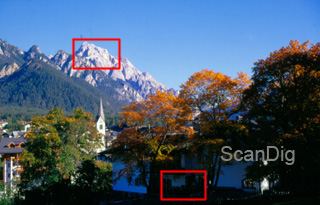
Also the range of density of the ScanMaker s480 is relatively low. In the case of scanning transparent originals, it happens soon that the scans, either in the bright portions as also in the shadows do barely have a definition or no definition at all. We have added the red marked areas of the showed scan of a slide positive as a 100% cutout, so that you can get a picture by yourself.
There is no dust and scratches removal, neither based on the hardware nor as a feature of the scan software. Thus, the later correction is not possible.
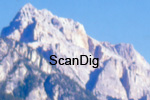
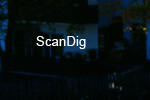
The ColorRescue-function for the automatic colour restoration that is highly promoted by Mikrotek sounds good, but it does not do anything else than pushing the tonal values together in each colour canal. In the case of many originals, this leads to the desired result, but in much others not.
Thus, the Image quality of the Mikrotek ScanMaker s480 is not convincing. Soon it gets clear that the scanner is not designed for the archive of slides negatives but rather as an odd job, it sometimes digitalizes one or two negatives or positives.
Scan Speed
The scanning times shown in the following table were detected with a computer connected per USB 2.0 and with a single-core Pentium 3.2 GHz processor and 2GB memory.
| Format / Resolution |
Positive-Scan |
Negative-Scan |
| Small Image 2400ppi |
1:02 min |
1:58 min |
| Small Image 4800ppi |
1:02 min |
1:58 min |
| 6x7cm 2400ppi |
2:17 min |
3:32 min |
| 4x5inch 2400ppi |
5:53 min |
4:52 min |
| Reflective Original 10x15cm 300ppi |
0:20 min |
- |
| Reflective Original 10x15cm 600ppi |
0:49 min |
- |
| Reflective Original DIN A4 (21x29,7cm) 300ppi |
0:53 min |
- |
| Reflective Original DIN A4 (21x29,7cm) 600ppi |
1:38 min |
- |
The pre-scan in case of transparent originals takes 0:55 minutes and in the case of reflective originals 0:25 min.
As one can see, the Microtek ScanMaker s480 either digitalizes reflective as also transparent originals in a relatively short time. It is not clear how it happens that in the case of large format films, the time of a negative-scan is shorter compared to the positive-scan. The fact that the scanning times do not differ in the case of 2400ppi and 4800ppi, would actually point out that the sensor cannot scan with an optical resolution of 2400ppi and this is why it scans it with the next available higher resolution - in this case 4800ppi - and afterwards, the software scales the picture down. But during a comparison with some larger originals, the 4800ppi-scan takes considerably more time.
Resume, Conclusion
The Microtek ScanMaker s480 provides the results that are expected of a flat bed scanner of this price level. The image quality is well sufficient for reflective originals, but in the scan of film material it is not convincing. The much too low resolution and the small range of density limit the use of the transparent original-scan to contemplate it on screen or do some small printouts with the home printer. They are not suitable for some high quality print copies on photo paper.
But kudos to the scanner for its fresh and flat design, the integrted light guide and its low price. Also the narrow and sloped edges for the easy scanning of books is very laudable.
Thus, those who mainly want to do some scans of reflective originals and only occasionally want to digitalize some film material for example for sending it by e-mail, will get with the Microtek ScanMaker s480 a low-priced and fancy scanner for their home.
Purchase of scanners
Visit our Filmscanner-Shop, the only shop on internet that is specialised on filmscanners and accessories. We provide you with every scanner to a very attractive price and we provide you, also after the sales, with accessories as film adapters or optional adapters.
Back to the index Filmscanner-Test Reports
|